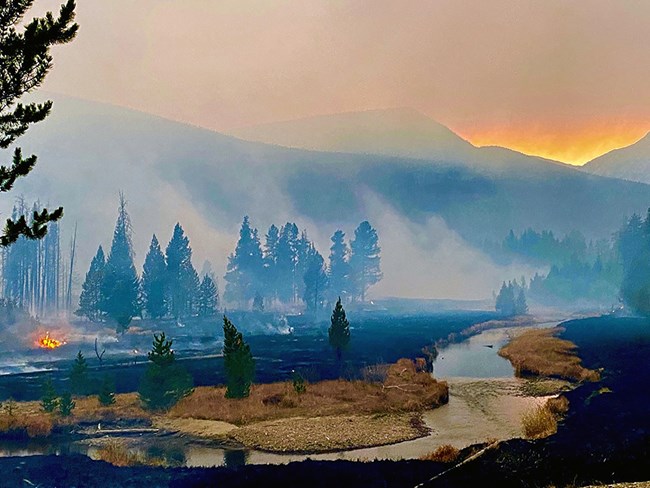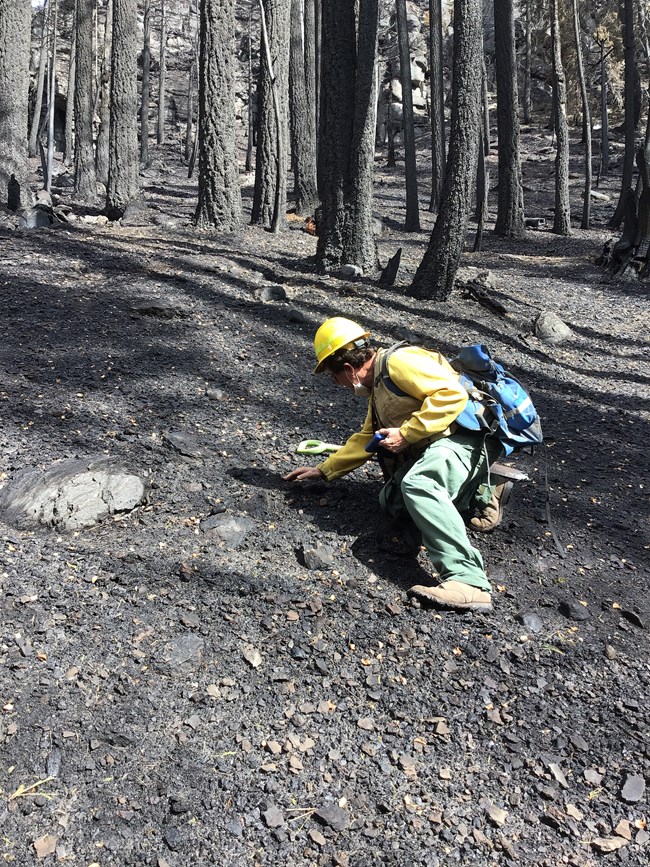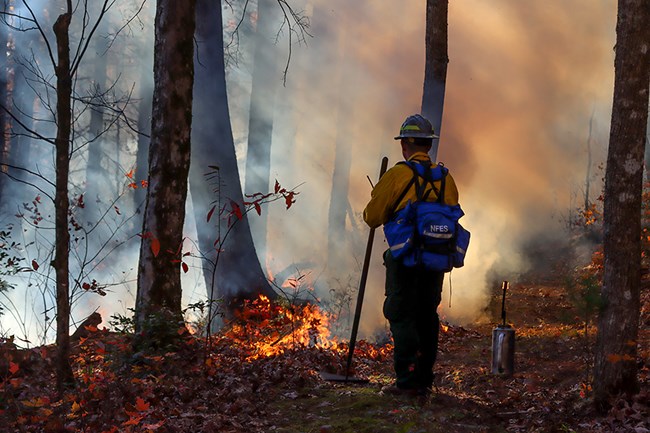
NPS, C. Kopek
When faced with wildfires, agencies must balance human safety, structure protection, and resource needs, and the National Park Service reflects this in its Wildland Fire Strategic Plan. Immediately suppressing all fires results in fuel buildup which will cause more severe fires in the future.
The range of options available for response to a wildfire include:
This is an active operation where firefighters are observing fire behavior to ensure the fire does not cross a containment line. Firefighters can quickly act to stop a spot fire or slopover. Firefighters are also evaluating whether management objectives are being met and this information is shared with operation leadership on the incident to assess and shift tactics if needed.
Spot fire - a fire outside the fire perimeter.
Slopover - the fire crosses a containment line or natural barrier.
Spot fire - a fire outside the fire perimeter.
Slopover - the fire crosses a containment line or natural barrier.
Managing a fire perimeter by a combination of direct and indirect actions and use of natural topographic features, fuel, and weather factors.
A control line has been completed around the fire and around any associated spot fires; this can reasonably be expected to stop the fire’s spread. The Blue Jay fire, in Yosemite NP was an excellent example of use of confine and contain tactics.
Protecting specific assets or highly valued resources, such as buildings, from the wildfire with handline, water, foam, or other tools, without directly halting the continued spread of the wildfire.
All the work that goes into extinguishing or limiting wildfire spread.

NPS, A. Williams
In wilderness areas, wildfire is often managed by Minimum Impact Strategy and Tactics (MIST), which means applying tactics that effectively meet management and resource objectives with the least environmental, cultural, and social impacts. The mechanics used to suppress fires outside of wilderness can include use of bulldozers, masticators, and other tools to cut line, in addition to dropping fire retardant. These would have a large impact on wilderness and would require firefighters to travel long distances into remote areas, risking safety and making resources unavailable to other incidents. Therefore, MIST often make much more sense in wilderness.
Finally, even before a fire is fully contained, and active firefighting activities cease, activities to rehabilitate and restore fire damaged lands begin. These efforts sometimes continue for a significant time after the fire is contained. Burned Area Emergency Response (BAER), also called Emergency Stabilization, consists of planned actions taken to minimize threats to life or property and to stabilize post-fire resource degradation resulting from the effects of a wildfire. The actions are planned and initiated within seven days from containment of the fire and need to be completed within one calendar year from fire containment. Not every fire receives BAER treatment. Natural rehabilitation is preferred; but when that is not possible, BAER comes into play. In the longer term, non-emergency efforts, referred to as Burned Area Rehabilitation (BAR), include efforts undertaken within three years of a wildland fire to repair or improve fire-damaged lands unlikely to recover to management approved conditions or to repair or replace minor facilities damaged by fire (NWCG, 2021). Both BAER and BAR include assessment and creation of a plan in order to develop treatment options following a fire.
NPS fire management plans allow for a wide variety of ways to manage vegetation and respond to wildfires. Having a plan in place allows the NPS to choose the option or options that best meet the individual circumstances of an incident accounting for the features of the landscape where it occurs. We track our success by building measurable objectives. Not allowing a wildfire to get past a creek bottom, or making sure bare mineral soil is available after a fire for giant sequoia seedling establishment are both examples of objectives we might use. When a fire is burning in steep, inaccessible terrain, we might use a confinement strategy, allowing the fire to burn within a pre-established area and placing firelines in areas where firefighters can safely go, or using helicopters to cool areas along a perimeter of a fire to keep it in check.
Safety is our core value. Safety of firefighters and the public is the number one priority of all NPS wildland fire management activities. The NPS approach is designed to increase safety for firefighters through less exposure on the fireline, and to increase effective use of available resources while reducing the hazardous accumulation of overgrown vegetation. Balancing the need for fire prevention and suppression while also using fire as a tool to protect people, communities, and values at risk is essential for effective wildland fire and land management.
Safety is our core value. Safety of firefighters and the public is the number one priority of all NPS wildland fire management activities. The NPS approach is designed to increase safety for firefighters through less exposure on the fireline, and to increase effective use of available resources while reducing the hazardous accumulation of overgrown vegetation. Balancing the need for fire prevention and suppression while also using fire as a tool to protect people, communities, and values at risk is essential for effective wildland fire and land management.

NPS
Social and cultural approaches to wildland fire over the past century often focused on preventing and suppressing wildfires, leading to a dangerous build-up of vegetation in our wildlands. The NPS Wildland Fire Management Program is grounded in science, and we continue to increase our understanding of the essential role fire plays in our environment. As Hal Rothman describes in the publication, “A Test of Adversity and Strength: Wildland Fire in the National Park System,” fire management in the National Park System has evolved from mainly full suppression in the early to mid-1900s, to use of a wider range of tactics today, as our knowledge has expanded.
Managing wildfires is not a “one size fits all” formula. Many factors go into determining when fire should be suppressed, when it should burn naturally, or when some combination of tactics should be used. When determining best tactics to use, safety of firefighters and the public, the health of our natural resources, and protection of cultural resources, are always at the forefront.
References
Rothman, H. 2005. A Test of Adversity and Strength. Wildland Fire in the National Park System. U.S. Department of the Interior, National Park Service. Wildland Fire Program. https://www.nps.gov/subjects/fire/upload/wildland-fire-history.pdf
Last updated: January 27, 2025
